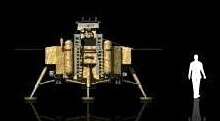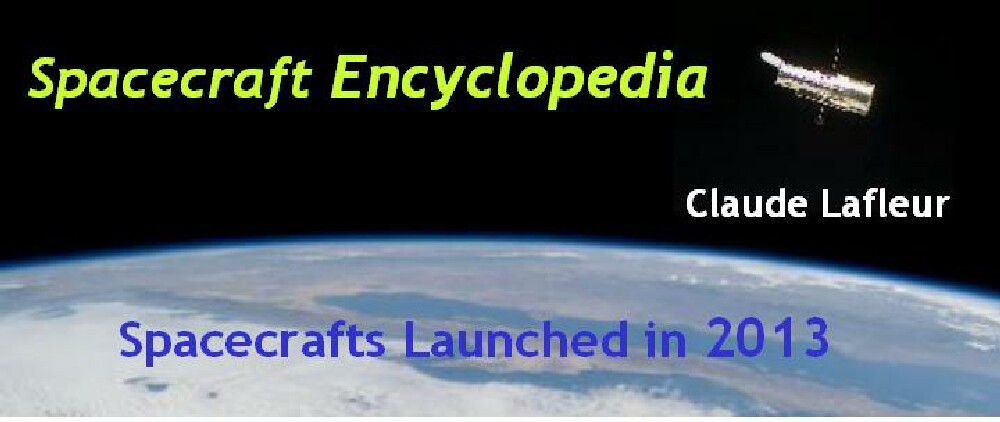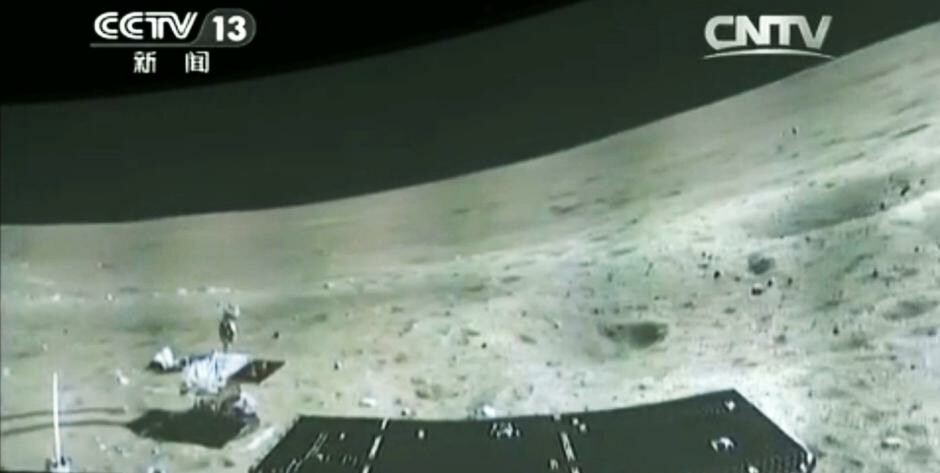Chang'e 3
| Spacecraft: |
Chang’e is a mythological goddess
that went to the Moon with a rabbit named Yutu. |
| Chronologies: |
2013 payload #188 ; 2013-70A ; 7,446th spacecraft. |
| Type: |
Lunar Probe (Lander) |
| Families: |
|
| Ranks: |
|
| Sponsor: |
China |
|
|
| Launch: |
1st December 2013 at 16h30 UT, from Xichang
Launch Center, by a Chang Zheng 3B. |
| Orbit: |
Initial: 210 km x 389,109 km x 28.5°IEarh
orbit)
6 Dec 13: 100 km circular orbit around the
Moon.
On the lunar surface since 14 December 2013. |
|
 Source: Xinhua
Source: Xinhua
|
| Mission: |
Chang'e 3 is a 3,800-kg lunar
lander that has a descent engine and landing legs. It carries a variety
of lunar surface experiments, including the Yutu rover. It is the first
Chinese lunar probe schedule to land on the Moon and is China's most ambitious
planetary mission to date.
 Chang'e 3 landed about 43 km south of crater Laplace F in the Mare Imbrium
(19.51° West and 44.12° North), on 14 December 2013 at 13h11 UT,
Thus, (Note: The original planned landing site was in Sinus Iridum (Bay
of Rainbows) but the Chinese decided to land one orbit early, with the
probe flying a little further east over Mare Imbrium (Sea of Rains).) China
became the third country ever to carry out such a rover mission after the
United States and former Soviet Union. (This was the first lunar soft landing
since the USSR's Luna 24 in
1976.) The Chang'e-3 lander conducted in-situ exploration at the landing
site for one year.
Chang'e 3 landed about 43 km south of crater Laplace F in the Mare Imbrium
(19.51° West and 44.12° North), on 14 December 2013 at 13h11 UT,
Thus, (Note: The original planned landing site was in Sinus Iridum (Bay
of Rainbows) but the Chinese decided to land one orbit early, with the
probe flying a little further east over Mare Imbrium (Sea of Rains).) China
became the third country ever to carry out such a rover mission after the
United States and former Soviet Union. (This was the first lunar soft landing
since the USSR's Luna 24 in
1976.) The Chang'e-3 lander conducted in-situ exploration at the landing
site for one year. |
| Notes: |
Wreckage of the Chang’e 3 launcher fell in
a village in Suining county, Hunan province, damaging two houses. No casualties
were caused, according to official sources. The resident of one of the
houses was compensated $1,750, and the other received $850 after authorities
assessed the damage.
The launching of
the lunar probe had forced the Suining county authorities to relocate 160,000
residents before the rocket blasted off. and more than 20,000 residents
living near the Xichang Satellite Launch Center were relocated to an auditorium
at a primary school. Yu Menglun, a rocket scientist, told that China's
rockets are able to maintain a fixed region for the dropping of wreckage.
"Normally we select the scarcely populated areas. The scope of the region
is in general 50 to 70 kilometers long and 30 km wide," he said.
But Chinese experts
believe the country needs an insurance plan to cover property losses, or
even deaths or injuries, after space launches. "Compared with the cost
of the whole space mission, damages caused to third parties are a tiny
amount," said Zhang Jianheng, deputy general manager with the China Aerospace
Science and Technology Cooperation. (See China Daily's report.)
By mid-December
2014, Chinese media reported that Chang'e-3 has finished all its scheduled
tasks after 13 lunar day and night cycles since its soft landing
and will continue to carry out additional tasks. During its year on the
Moon's surface, which included 13 dormancies on lunar nights and awakenings
on lunar days, the lunar probe carried out more than 30 radio surveys,
says Cui Yan, chief designer of the Chang'e-3 lunar program. "But given
its good condition, we plan to conduct further experiments to accumulate
more technical experience for China's deep space exploration," says Cui. |
| Source: |
Jonathan
Space Report No. 690,
691
;
NSSDC2013-070A
; Spaceflight Now's 9
Jan 12, 2013 Stories,
2014
Stories ; China Daily's
11
Nov 12, 6
Mar 12, 13
Mar 12, 4
Sep 13, 26
Nov 13, 26
Nov 13, 26
Nov 13, 27
Nov 13, 27
Nov 13, 29
Nov 13, 30
Nov 13, 1
Dec 13, 2
Dec 13, 2
Dec 13, 3
Dec 13, 3
Dec 13, 3
Dec 12, 4
Dec 13, 6
Dec 13, 6
Dec 13, 9
Dec 13, 11
Dec 13, 15
Dec 14 ; Xinhua's
2
Mar 11,
2
Apr 11, 21
Sep 11, 29
Dec 11, 13
Mar 12, 31
Jul 12, 28
Aug 13, 28
Aug 13, 4
Sep 13, 12
Sep 13, 13
Sep 13, 27
Oct 13, 27
Oct 13, 27
Oct 13, 28
Oct 13, 26
Nov 13, 26
Nov 13, 26
Nov 13, 27
Nov 13, 29
Nov 13, 29
Nov 13, 29
Nov 13, 30
Nov 13, 1
Dec 13, 1
Dec 13, 1
Dec 13, 1
Dec 13, 1
Dec 13, 1
Dec 13, 1
Dec 13, 1
Dec 13, 2
Dec 13, 2
Dec 13, 2
Dec 13, 2
Dec 13,
2
Dec 13, 2
Dec 13, 3
Dec 13, 5
Dec 13, 6
Dec 13, 11
Dec 13, 14
Dec 13, 14
Dec 13, 14
Dec 13, 14
Dec 13, 14
Dec 13, 14
Dec 13, 14
Dec 13, 14
Dec 13, 14
Dec 13, 14
Dec 13, 15
Dec 13, 15
Dec 13, 15
Dec 13, 16
Dec 13, 16
Dec 13, 16
Dec 13, 16
Dec 13, 17
Dec 13, 18
Dec 13, 21
Dec 13, 24
Dec 13, 11
Jan 14, 11
Jan 14, 12
Jan 14, 17
Jan 14, 25
Jan 14, 23
Feb 14, ; Gunter's
Chang'e
3 (CE 3) / Yutu ; |
|
|




